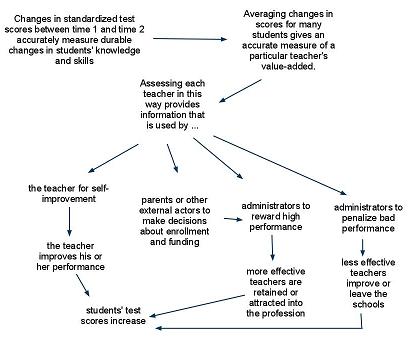« Jonathan Lethem, A Fortress of Solitude | Main | students as part of the accountability puzzle »
September 1, 2010
the value-added debate in education policy
The debate about assessing teachers' impact has reached full volume. The Los Angeles Times recently released a public database that rates teachers' "value added," the New York Times has a new front page article about that kind of method, the Economic Policy Institute has published an important paper by 10 famous authors against it (pdf), and various prominent bloggers have weighed in.
We must assess the performance of public employees whom we pay for important public tasks--teachers included. Everyone who has ever been inside a school knows that teachers differ in their skills, relevant knowledge, and motivation. Once upon a time, we trusted educators--teachers, administrators, and unions--to assess themselves, but there is pretty broad dissatisfaction with that approach today.
The leading solution--enshrined in federal and state law--is to use standardized test scores to assess teachers. But now we're supposed to use them in a sophisticated way, not just looking at the average score for each class (which is evidently affected by many factors other than the teacher). The leading sophisticated approach is to assess average changes in a teacher's students over time. In essence, that method controls for students' starting position and relies on the Law of Large Numbers to even out random or external factors that might affect any given kid.
It's not a crazy theory--it has some research support, especially from the groundbreaking work of William Sanders--but notice how many premises and causal relationships the full strategy assumes:
This can go wrong in so many ways. Tests can be poor measures of students' competence: they are never perfect measures. The Law of Large Numbers does not apply in this case, because each teacher can have a significant impact on only a modest number of kids. Hence there are large random fluctuations in value-added scores.
I have never seen evidence that parents try to place their kids in schools with the highest "value-added" teaching staffs. It would be odd if they did, because a student benefits more from a privileged peer group or a good school climate for learning than from teachers who add the most to standardized tests. (Larger increases can be achieved in low-income schools that don't face "ceiling effects," but you don't see affluent parents enrolling their kids in those schools to reward the teachers.)
When teachers use standardized test scores to modify their own performance, they often "teach to the test" and narrow the curriculum. When administrators use such data, they do not consistently enhance the strength of their teaching staffs; they certainly don't make the workplace more desirable for talented teachers. Even if a school's faculty does add more average value to test scores, that doesn't mean that graduates will become better citizens--or even that students will stay in school.
Kevin Drum thinks we face a Hobson's Choice: no tests and no accountability, or poor accountability through testing. "The criticisms of value-added seem compelling. At the same time, if a teacher scores poorly (or well) year after year, surely that tells us something? At some point, we either have to use this data or else give up on standardized testing completely."
I'm not saying that the answer is easy, but there are alternatives to this dilemma. We could reorganize schools so that teachers were able to hold one another more accountable: what I have called "internal accountability." (Evidence from other fields shows that when internal accountability system are replaced with external measures, people become less motivated to do good work.) We could also bring parents into schools as partners, not just consumers, and boost what I have called "relational accountability."
Either way, we would shift the metaphor. Teachers wouldn't be service-providers whose service must be measured in a standardized way. They would be members of a community (also comprised of families), who hold one another accountable for contributions to a common task.
These ideas may sound idealistic, but they actually make fewer assumptions and leaps of faith than the supposedly hard-nosed strategy shown in the diagram above--which is embodied in current law.
September 1, 2010 2:15 PM | category: education policy | Comments
Comments
nonePost a comment
Thanks for signing in, . Now you can comment. (sign out)
(If you haven't left a comment here before, you may need to be approved by the site owner before your comment will appear. Until then, it won't appear on the entry. Thanks for waiting.)